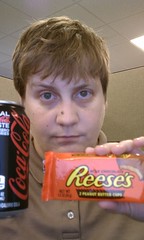
Some of you may know that I enjoy singing in choirs/choruses/chorales these days, even doing a solo every now and then, but I’ll bet few of you know that I was too shy to sing in front of most people until my second year of college. Most of my college friends could sing pretty well, and many of them were in the university chorale or the chamber choir. I loved singing, but I was too nervous and shy to audition, as much as I wanted to. Somehow, they convinced me to take a voice class. Not private lessons, but with a small group of students and one teacher, all at once.
This was safe for me to start out in. We sang everything together, until our final, and that was the first time I’d sung for real, alone, in front of anyone. It was terrifying! But it also gave me the courage to go through the audition process the next year, and I was in the chorale for the second half of my college career.
Since then, I’ve sung with Sacred Harp groups, church choirs, community women’s choruses, and a university women’s chorus (I still sing with two groups that fit in the last two categories). It’s been an amazing learning experience, and I sometimes marvel at how a person who was too shy to sing in front of a handfull of friends can now stand on stage and sing in front of hundreds of strangers.
In college, I was obsessed with singing low. I was proud to sing the alto part, and one of my fellow altos and I would frequently try to hide with the basses until our director made us go back to our section. For me, alto meant harmony and something interesting. Soprano seemed, well, boring.
These days, I sing first alto or second soprano, depending on the group and the arrangement. And the strange thing is, I’m finding that the low notes aren’t as much fun anymore, and sometimes are rather uncomfortable to sing. My voice, as women’s voices do, has been changing and maturing over the years. When I moved over to the second soprano section in my community women’s chorus last year, it was the first time I acknowledge that shift to anyone, including myself. It was a bit of an identity crisis at first, but I’ve come to embrace it.
Back in that voice class in college, my instructor called me a “chicken soprano,” and she was right. I could sing higher than I was willing to (or brave enough to) back then. Now I know I can, and I have quite often. The strange thing is, I can feel my voice changing. I started noticing this on octave leaps that would take me up to the C above middle-C, and beyond. They didn’t feel strained anymore — I just thought it, and then sang it with confidence.
My ear is much better. I have a good sense of certain notes and placement and intervals, although I couldn’t tell you what a perfect fourth or a major seventh sounded like to save my life. Those names never stuck with me. But, I can sight read pretty well, if you give me a starting point, and back in the day I had to hear it a few times before I could follow along.
So, I’m moving into my upper range, and it feels fine. But also weird. Sometimes, I can’t trust my sense of place anymore, because what feels like a G may be something else entirely now. My voice breaks are shifting, or maybe I’m just not as aware of them anymore.
This makes me feel less certain. Unbalanced. And it doesn’t help that I’m turning 37 this year.
Back to that voice class and the instructor who told me I was a chicken soprano… she also told us that women’s voices hit their peak maturity around age 37. To my 19-year-old mind, that seemed like a future so distant I couldn’t even imagine it, and now I’m here. Or nearly there.
People talk about how turning 30 wasn’t as big of a deal as turning 31. I get that. For me, as a woman and a singer, I think this 37th birthday is going to be more significant than either of those previous milestones. I’m just not sure if I’m ready for that to happen yet. Luckily, I have about six months to figure it out.




